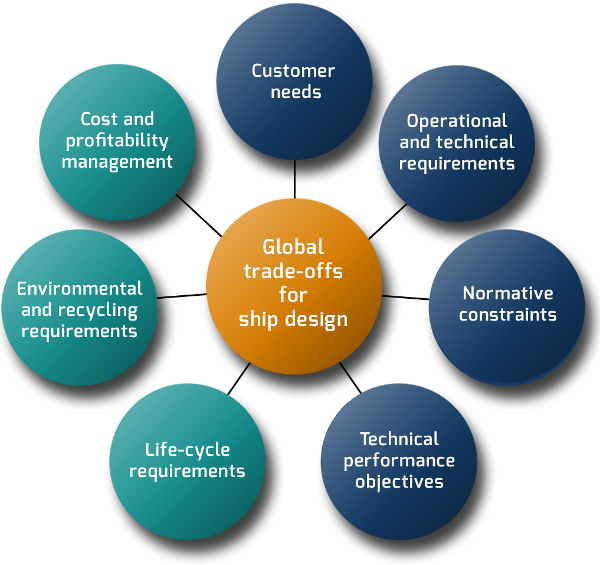HOLIShip
Motivation and research challenges
Maritime assets such as ships and offshore platforms are typically associated with large investments and are not often built in large series. Where air, rail and road transport benefit from the scale effects of series production and considerable lead time of product development, this is mostly not the case for maritime products. Advanced product design needs to reflect constantly extended requirements and assure a flexible use and optimised performance over the entire life-cycle for varying operational conditions. This calls for largely improved design tools including multi-objective and multi-disciplinary optimisation and, finally, virtual testing of the overall design and its components.
Today’s need for one-of-a-kind designs often results in an insufficient knowledgebase, inadequate lead time for complete optimisation cycles and an incomplete interplay between different design disciplines. Furthermore, there are uncertainties and changes in future operational requirements over an asset’s life-time which need to be taken up in a holistic life-cycle optimisation. HOLISHIP will address these shortcomings of present design processes (for maritime products) with a systems based approach.
The early design stage of any maritime product offers the widest range of solutions to be explored. It is at this design stage that the multi-disciplinary design approach has the highest flexibility and impact. ‘Higher design freedom’ and life cycle cost control at this preliminary design step allow optimising product design, taking into account all requirements. Being faced with the need to reduce operational costs and environmental impact while at the same time increasing safety, the maritime industry urgently needs to take up new life-cycle based design concepts including means for virtual testing of products.
It adds to the complexity of the problem that ship design is typically shared between design offices and yards in close cooperation with system / equipment suppliers, all requested to work on a design for optimal operational performance which increasingly becomes a prime selling point for a vessel.

Approach
HOLISHIP brings together all European stakeholders to improve the design of maritime products by combining the design objectives of the various disciplines involved.
HOLISHIP develops innovative design methods, integrating all design functional requirements and performance indicators like life-cycle cost, environmental impact, technical and regulatory constraints at an early design stage and accounts for the complexity of systems. HOLISHIP will provide an integrated design software platform for the entire life-cycle of the product enabling also virtual testing and demonstration.
Both concepts will lead to significant improvements during all life-cycle phases and for all industry players, design and engineering companies, shipyards, equipment manufacturers, ship operators and consultants involved in the team.
Main advantages for each industry group during the different phases of the life cycle are:
- Design [Yards, design / engineering companies, suppliers]: Reduce the duration of the design process, improve the designs and satisfy customer needs by exploration of an enlarged design space, while controlling the associated costs and risks.
- Production [Yards, suppliers]: Optimise the production process in terms of cost and duration.
- Operation [Owners]: Optimise vessel operations and associated cost for varying conditions.
- Maintenance [Owners, shipyards, suppliers]: Reduce the number, duration and cost of interventions and optimise the health monitoring of the vessels.
For the End-of-Life Phase of maritime products, advanced design systems will further ease the dismantling and the re-use of recyclable materials and components which will benefit the environment, owners and involved industry.
Objectives
HOLISHIP assembles a team of European leaders from the maritime industry, research and academia to perform the planned developments. HOLISHIP will specifically address the following main objectives:
- Develop Software (s/w) tools for multi-objective and multi-disciplinary holistic system optimisation and integration to design ships and offshore structures for operation, over the entire life-cycle.
- Develop and test a Virtual Vessel Framework (VVF) to be used in design optimisation and concept validation studies resulting in more efficient and safe ships.
- Improve ship design through improved operational feedback from a complex system into the design loop.
- Achieve measureable life-cycle cost reductions through innovative holistic ship design and demonstrate this for typical European applications.
- Reduce ship development time and costs through innovative design optimisation and integration procedures.
- Demonstrate methods to find optimal and innovative ship configurations according to measurable technical performances and ship operations.
- Set up full exploitation of the VVF after completion of the project to ensure continued use and improvements of the VVF.
- Disseminate and exploit the results gained from the project for the benefit of the European maritime industry.
Expected results
Achieving these objectives, the following project results will become available
- Multi-objective, -disciplinary and multi-fidelity ship design and optimisation framework coupling existing and novel design software tools to improve ship designs while reducing the design and development time.
- Library of multi-fidelity models and software tools for application in design optimisation or virtual vessel simulating.
- Virtual Vessel Framework for embedded ship simulation.
- A series of Application Cases, demonstrating and exploiting the HOLISHIP design approach.
The role of ISL in HOLISHIP
ISL provides market analyses based on historical data to the different application cases and vessel types respectively. The market data will be analysed and developed in order to provide the base for the concept optimisation process. This also requires developing scenarios, e.g. different fuel prices and their comparative ratios in the future. Starting from a general overview on related ship types and other marine assets, the input will include fleet development, including newbuilding orders and scrapping and as wellthe impact of ship management where appropriated. An analysis of the most significant parameters will be conducted; building prices, fuel costs and scheduled retrofits in order to support the definition of cost structures of vessels and marine assets.
Furthermore, ISL participates in the Life Cycle Cost asessement addressing the most relevant design aspects of the maritime products dealt with in HOLISHIP.

Project duration
09.2016 – 10.2021
Further information
Funding notice

Dieses Projekt wurde aus dem Horizon 2020-Programm für Forschung und Innovation der Europäischen Union im Rahmen der Finanzhilfevereinbarung Nr. 689074 finanziert.

